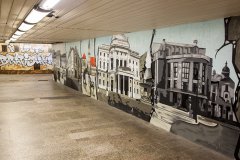Collaborative
Educative et basée sur l' Empathie
Culturelle
Participation
It is possible to reduce graffiti vandalism simply by planning mural projects. Mural projects create a sense of character in the area and involve local communities in regenerative actions, through arts or design practices. Brighton and Hove City Council pointed out that greater collaboration with artists and with residents offered them a ‘win win’ situation, that in their experience, left less of a graffiti problem, less money to be spent on cleaning (Leach and Barker, 2010).
Spiegel Online (2014) points out a prevention method that is tested in 2014 by the Chinese government to preserve the Great Wall. Tourists are allowed to scratch or spray their messages in a designated graffiti zone of the Great Wall. Based on know‐how at other sightseeing places this approach can massively reduce damage to monuments.
Some graffiti walls and mural projects have been recognised as an economic asset to local communities leading to regeneration of the area – e.g. bringing tourists to the areas, increasing property values and increasing business for traders, linked to arts led regeneration (Leach & Barker, 2010; Bristol City Council, 2011; Watts & Feeney, 2013; Young, 2014; BBC NEWS, 2014).
It is important to mention that there are mixed views on the value of the regenerative aspects of graffiti walls and mural projects (Stafford & Pettersson, 2003). The studies that evaluate the effectiveness of various approaches have different outcomes. For example, Stafford and Pettersson (2003) argue that legal walls and mural projects may attract graffiti to the local area. On the other hand, some studies argue that lack of spaces for practising graffiti safely, alienates young people and limits their mobility (McAuliffe, 2013).

